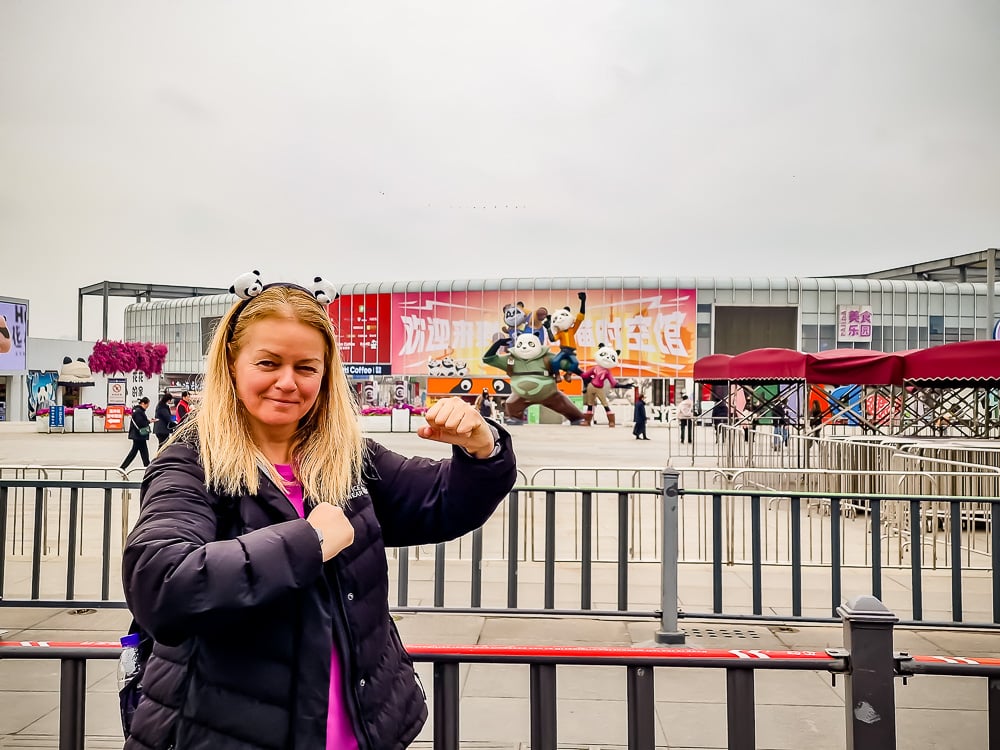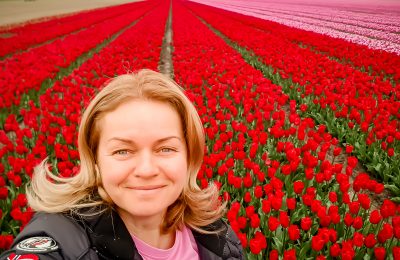God, I keep thinking I’m going to kiss those little bears on the nose!!! And how I’ll cuddle them, mess up their fur…
None of that actually happens, and I’ll tell you why. But I still get to meet them!
CHENGDU PANDA BREEDING AND RESEARCH CENTER
My first meeting with my guide in the city of Chengdu comes with a headband with two panda ears, which she gives me so I can instantly blend in with the local scene…
(Later, I would discover that, in the whole city, people wear something panda-related. Headbands like mine, panda bags or totes, panda keychains hanging from backpacks, and many, many other accessories that clearly “stamp” the city: we’re the Panda people!)
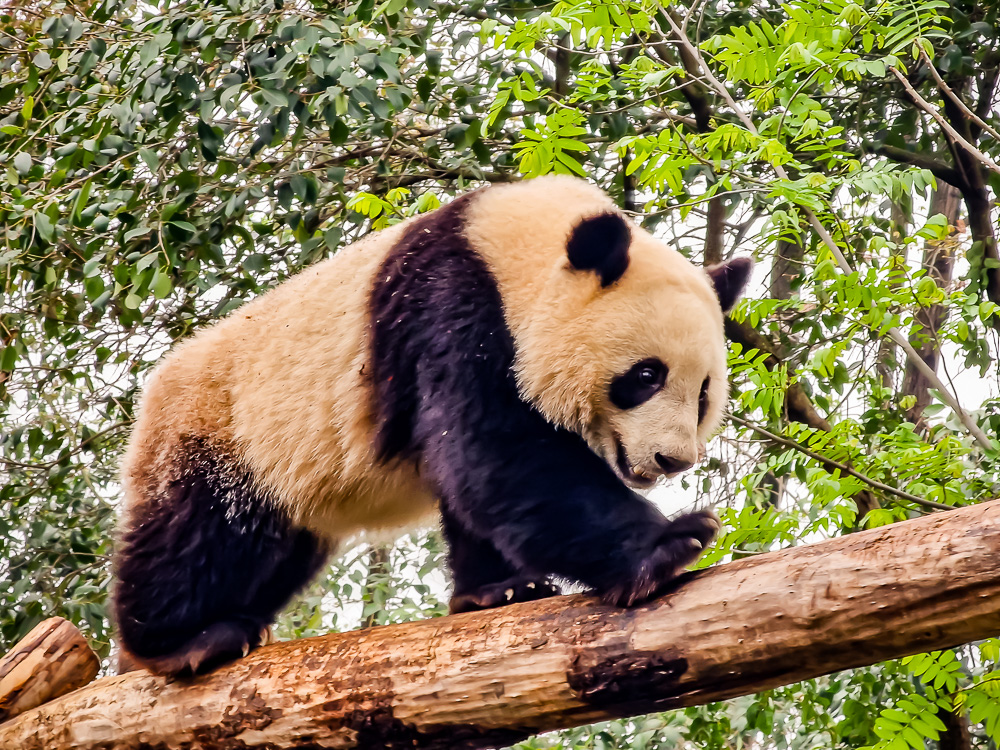
I have a ticket to a famous center, located just 10 km from downtown Chengdu, where you can see pandas – one of the rarest animals on Earth – in a semi-natural habitat.
Chengdu Research Base of Giant Panda Breeding was established in 1987 to save the species from extinction and is now among the most important centers in the world for panda breeding in captivity.

They even have a fancy guard here 🙂 Who seems to be just waiting to see your phone pointed at him, so he can show off his spectacular tail…
I ask if there’s a possibility to volunteer in this place, because that’s what I saw online – people feeding the cubs or cleaning their enclosures.
There isn’t. Since the pandemic, they’ve stopped that kind of activity. Instead, you can volunteer at another center – Wolong (Shenshuping) Panda Base, where you can actually interact with the pandas. But it’s a 2-3 hour drive from Chengdu. So I give up on cuddling the bears…
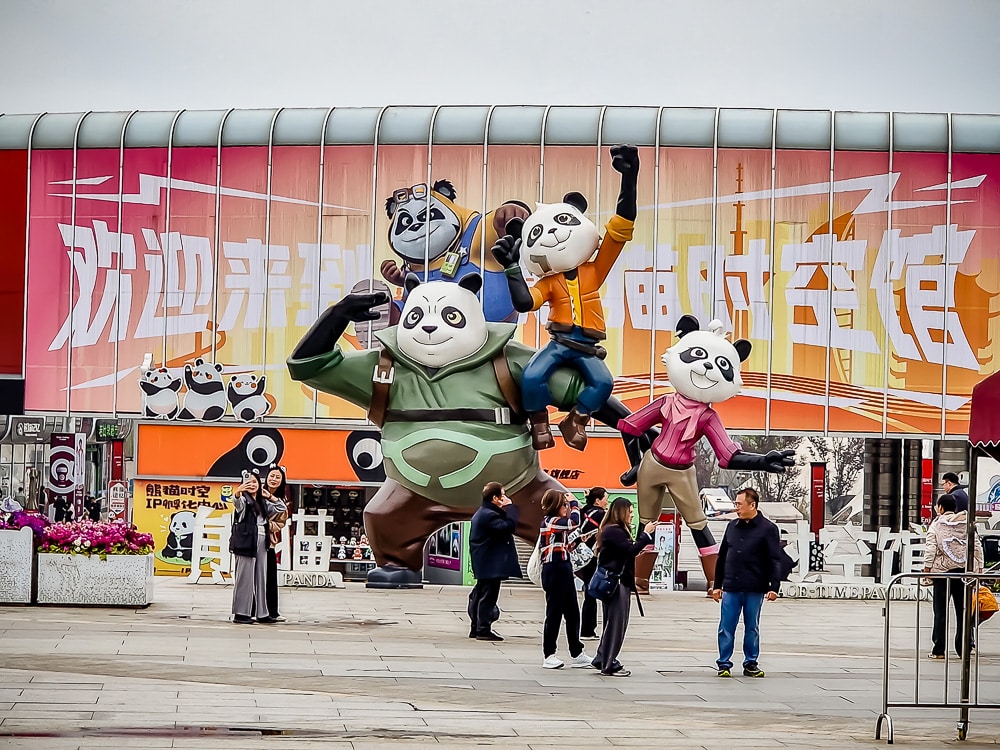
After I take a photo with the team of panda-fighters, my guide tells me not to expect to find any kung fu pandas here… Pandas are lazy, laid-back, often clumsy creatures.
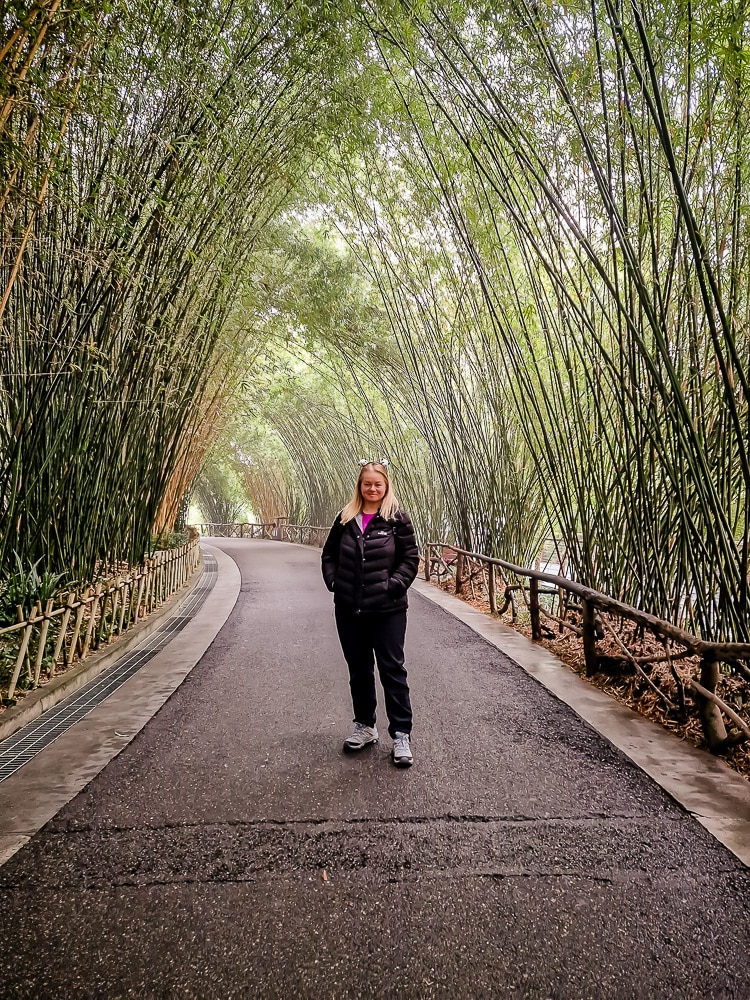
We walk along the bamboo-lined paths. It’s pretty chilly!
Here and there, I see signs with information/warnings about various things. From “keep your distance, don’t feed the animals”, to the fact that you need to keep your voice low, because pandas are very sensitive to noise; or that drones, rollerblades, scooters are not allowed, you can’t use flash photography, and live streaming activities are also prohibited.
Since I still don’t see a single panda in sight, I take the opportunity to find out as much as I can about them.
THE PANDA BEAR
There are around 2,600 pandas in the world. (1,700 of them live here, in the Sichuan region, in the wild and in centers. That’s why this area is considered their home.)
Out of the 2,600, 1,900 live in the wild. Practically all of them in China! 🙂 Because the panda naturally lives only in China, in remote mountainous regions.
The other ~700 are in breeding centers and zoos. Most of them still here, in China.
Zoos around the world “borrow” panda specimens from the Chinese, for limited periods, under a program called “panda diplomacy”. And here’s the cool part: if cubs are born in those zoos, they are sent back to China! That happens after 2 years, as soon as their mother finishes nursing them.
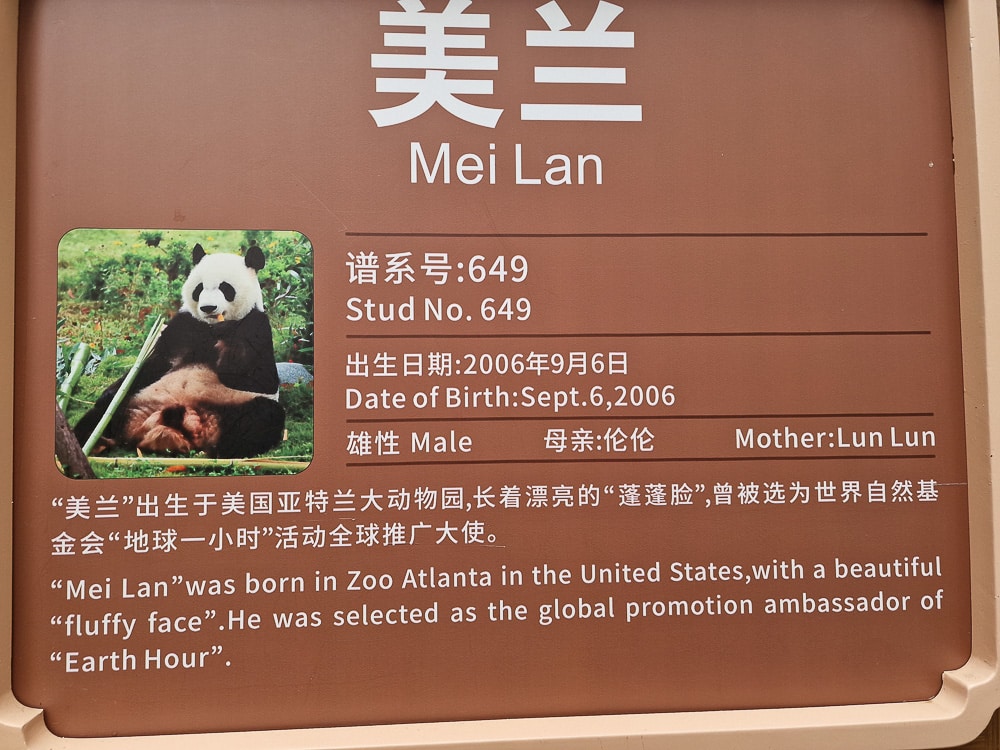
In this Center, you can see many pandas born in different corners of the world. All returned to their “motherland”.
On the other hand, some cubs born here are sometimes sent to other centers around the world, as part of conservation collaborations.
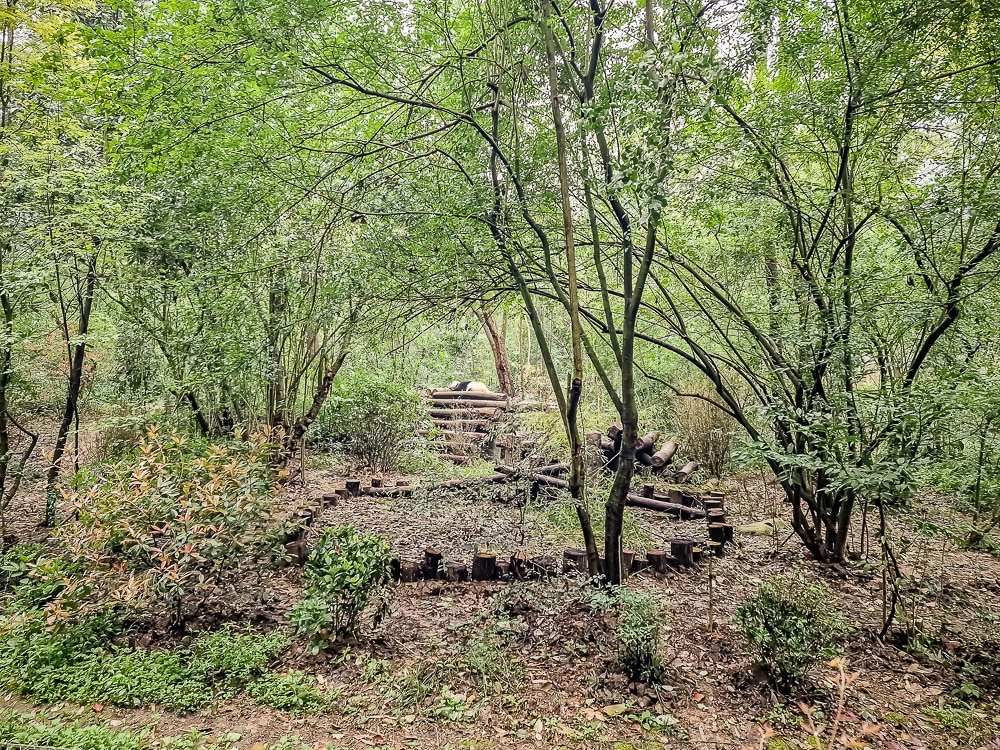
Wow… so many apartment buildings would’ve been built by us on the land where these bears live!…
Each bear has its own little forest, with elements to help it move around, relax. And to not care at all about visitors, as you can see. Can you see? 🙂
There are about 100 pandas in this Center (including the red ones, which I’ll write about a bit later). You can see everything from newborns to adults.
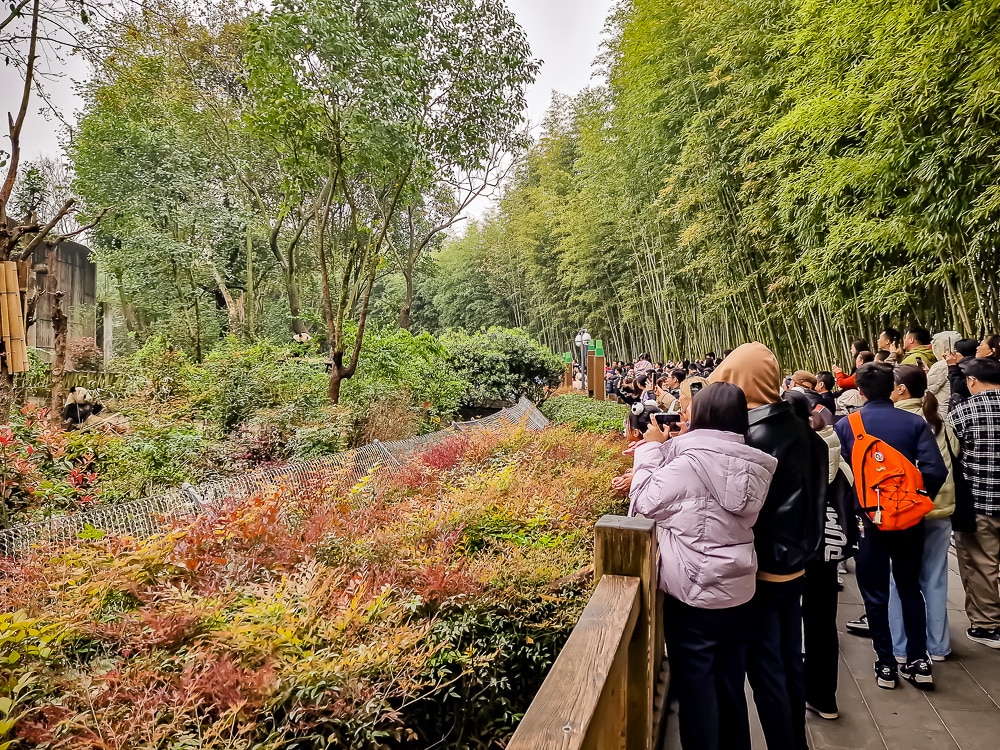
The best time to come here is early in the morning, when pandas are most active.
I wake up at the crack of dawn to be here by 8 AM. That’s breakfast time and you can spot the bears outside eating, playing, wandering around. During other times of the day, they might sleep inside, so you’d miss them. That’s also why mornings are the most crowded.
Also, keep in mind that pandas prefer cold weather. They only come outside when it’s cool and retreat indoors when it’s hot. So, if you visit during a heatwave, there’s a good chance you won’t see them past the fence…
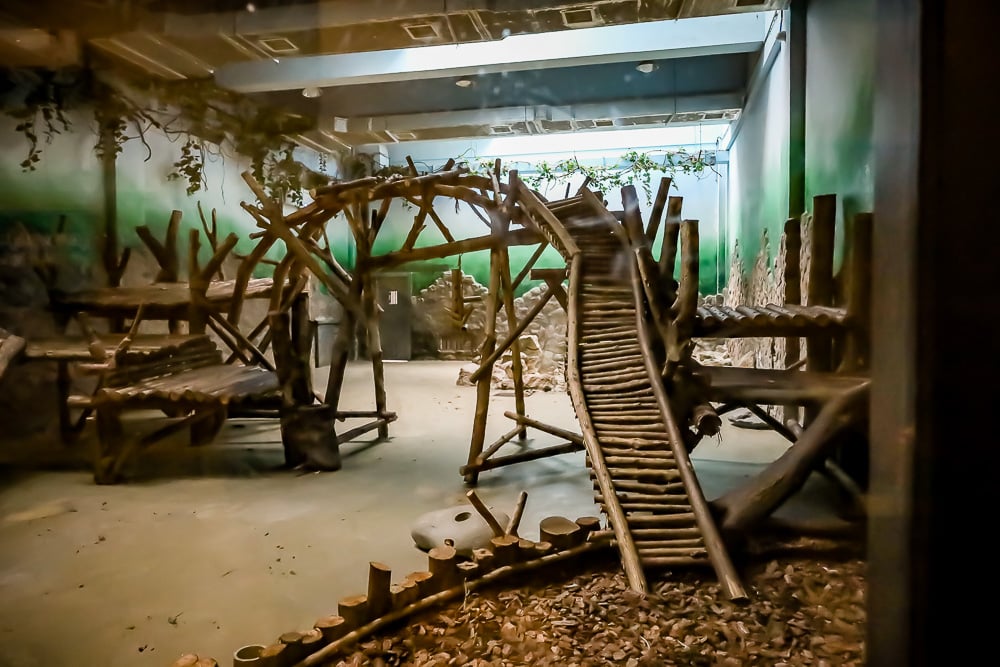
There are also indoor viewing paths for visitors, where you can spot the bears through glass when they’re inside. But the real charm is definitely outside!
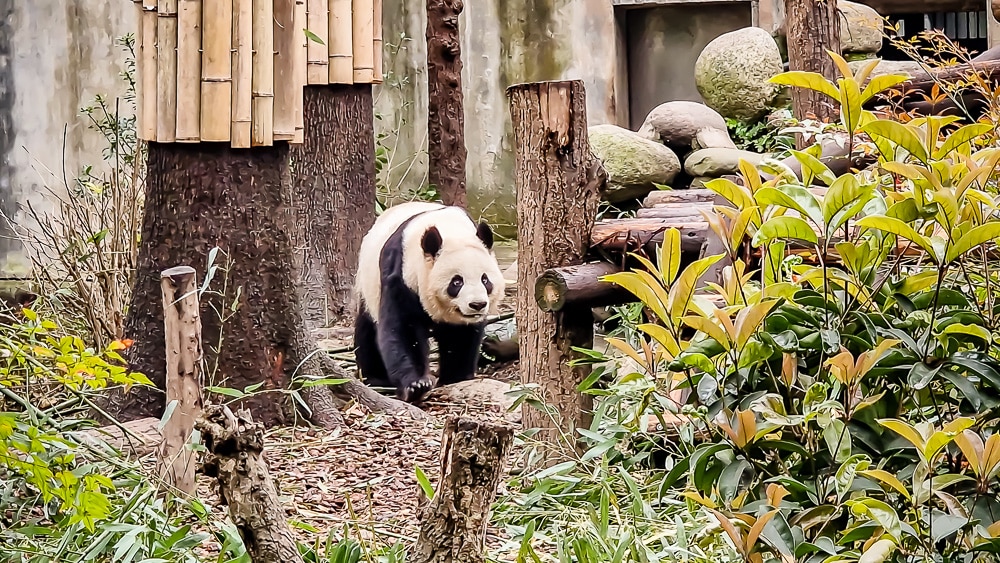
A mama panda gives birth once a year. The twin birth rate is 40%.
Artificial insemination is also done, to diversify the gene pool, I understand.
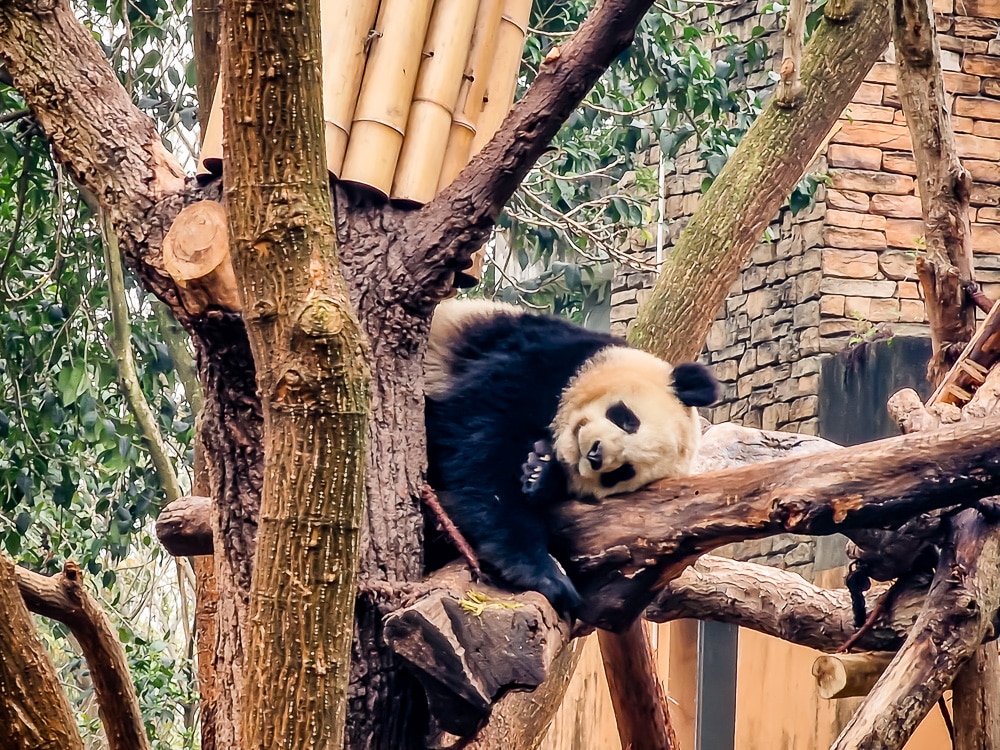
Pandas live about 20 years in the wild and 30 years in captivity.

Pandas’ diet is made up of over 99% bamboo, even though, biologically, they are carnivores.
They don’t get any meat here. In the wild, they chase bamboo, they move around a lot, so they need a protein source too – they eat eggs, rodents, small birds. Here, they don’t exert any effort, everything is handed to them “on a silver platter”, so their diet is adapted to this lifestyle.
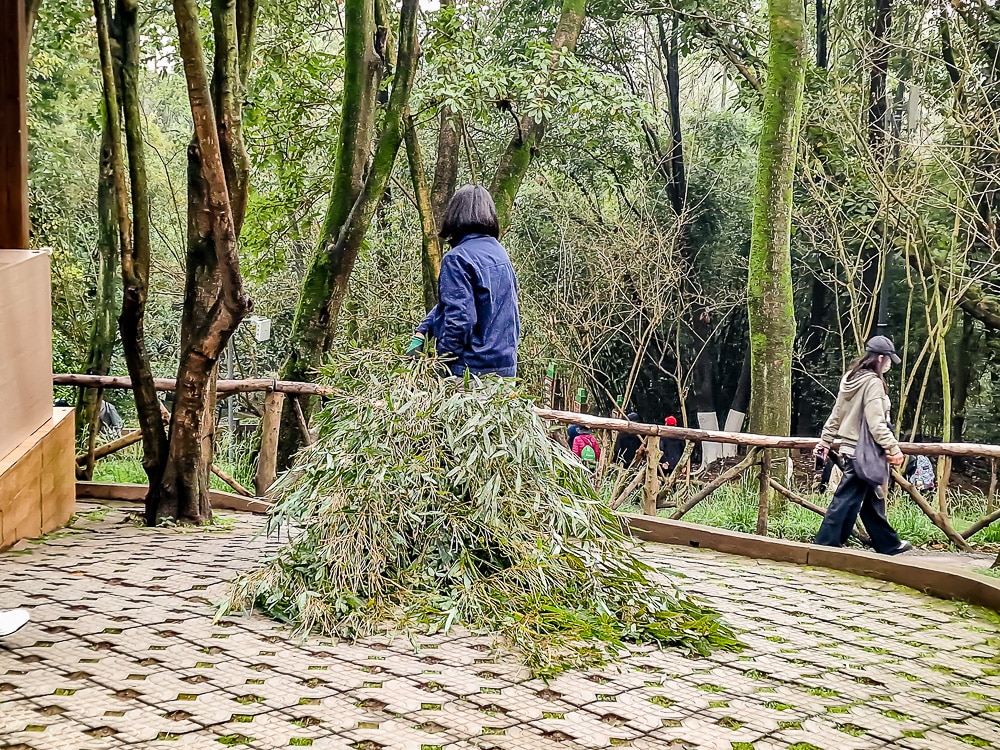
I had no idea there are 200 types of bamboo! And pandas eat only 60 of them. And only fresh bamboo! So you can imagine the work of those in these centers or in zoos…
All the bamboo that pandas don’t eat is collected and recycled. It’s turned into paper.
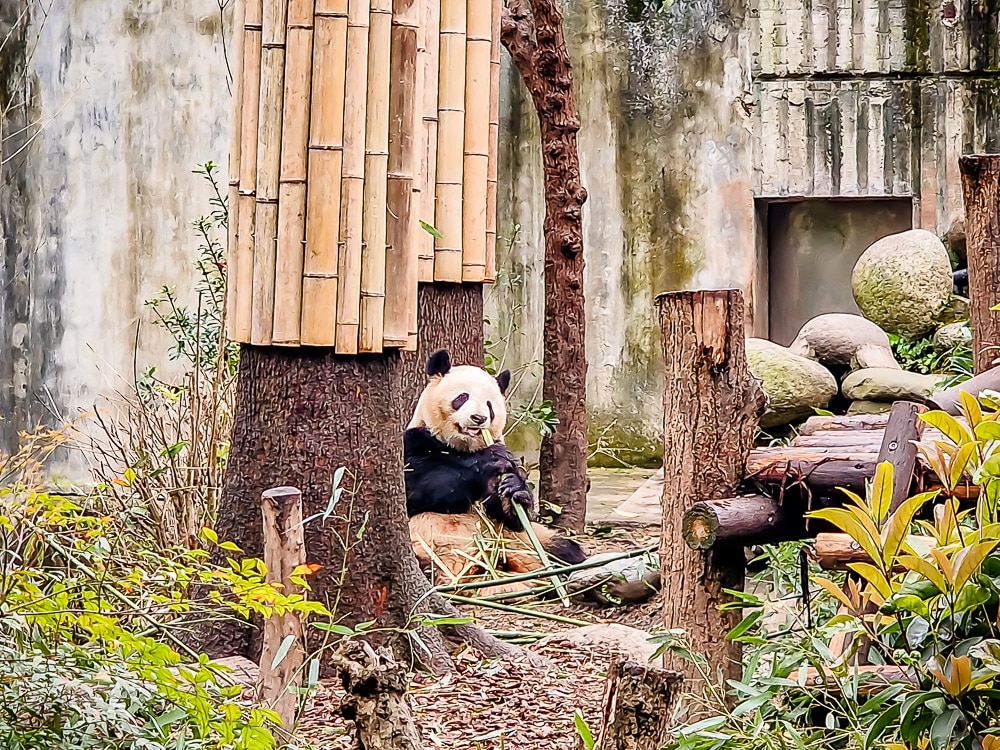
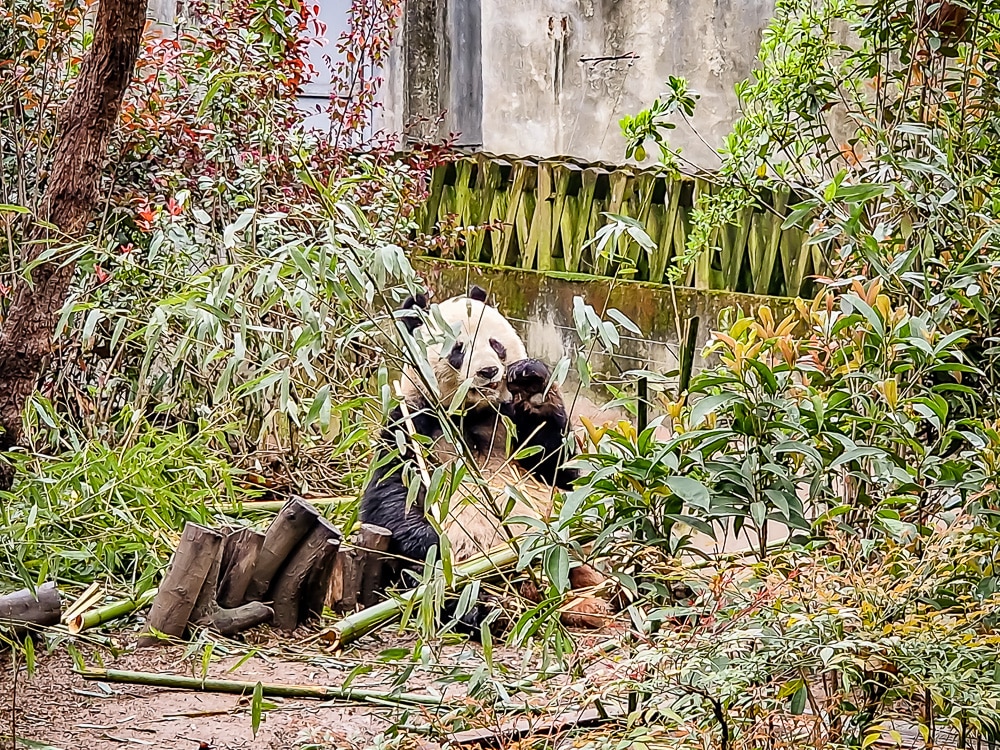
I filmed several pandas during their breakfast – and I wasn’t the only one.
The bears didn’t care about us at all. Until… one of them gave up the bamboo and started walking toward us:
We are safe 🙂
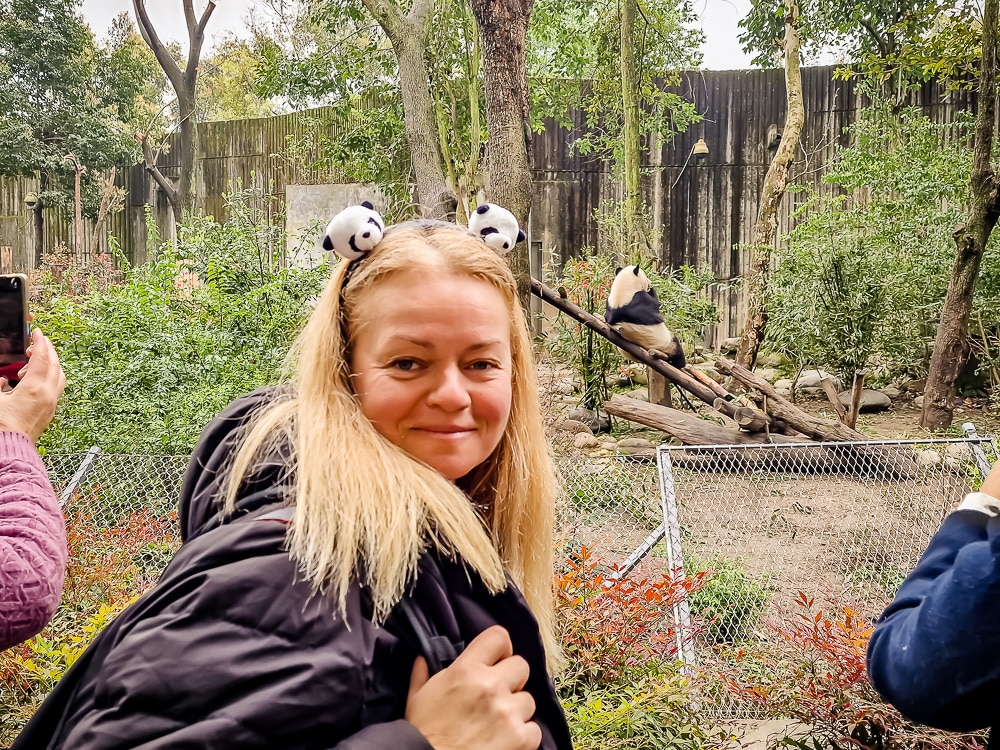
A panda can supposedly only see up to 2 meters away! It’s not scientifically proven, but what is certain is that they have pretty poor eyesight, especially during the day. Oh, and here I was thinking my panda headband would attract one for a selfie with two cubs and a kitten 🙂
Not only does he not see me, but he also greets me with… his butt.
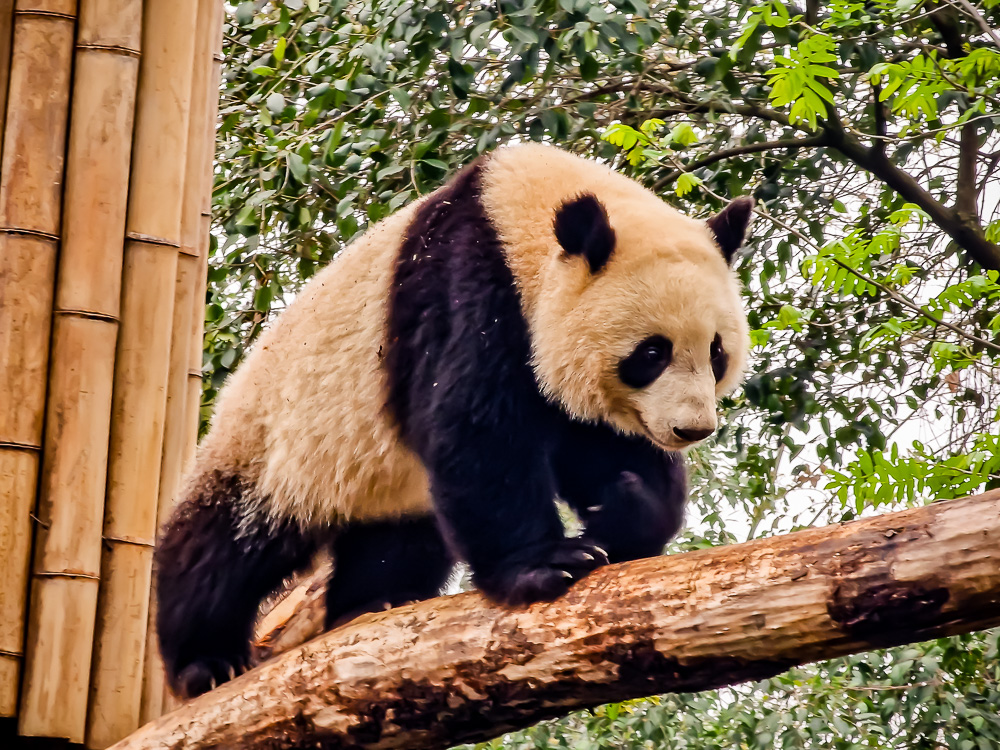
Pandas used to be hunted in China for their fur, for meat, and even for their paws, which were eaten. Just like in our country, though there you’d also mount the bear’s head on the wall to show off…
Since the 1960s, China has severely punished panda hunting: they throw you in jail for at least 10 years, confiscate your property, and in extreme cases, you get life in prison or even the death penalty!
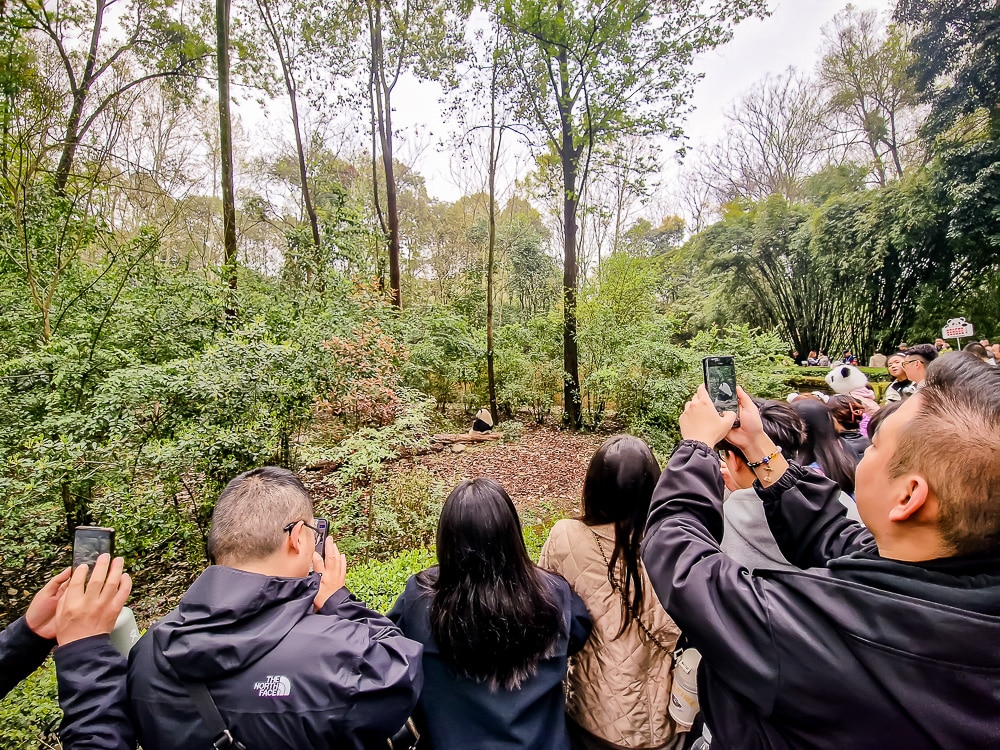
We walk from one bear to another on clearly marked paths. You can’t just go wherever you feel like and be buddy-buddy with the first panda you bump into.
There are areas with no access at all: areas with pregnant females, those with pandas that have certain disabilities, or the “retirement home for elderly pandas”.
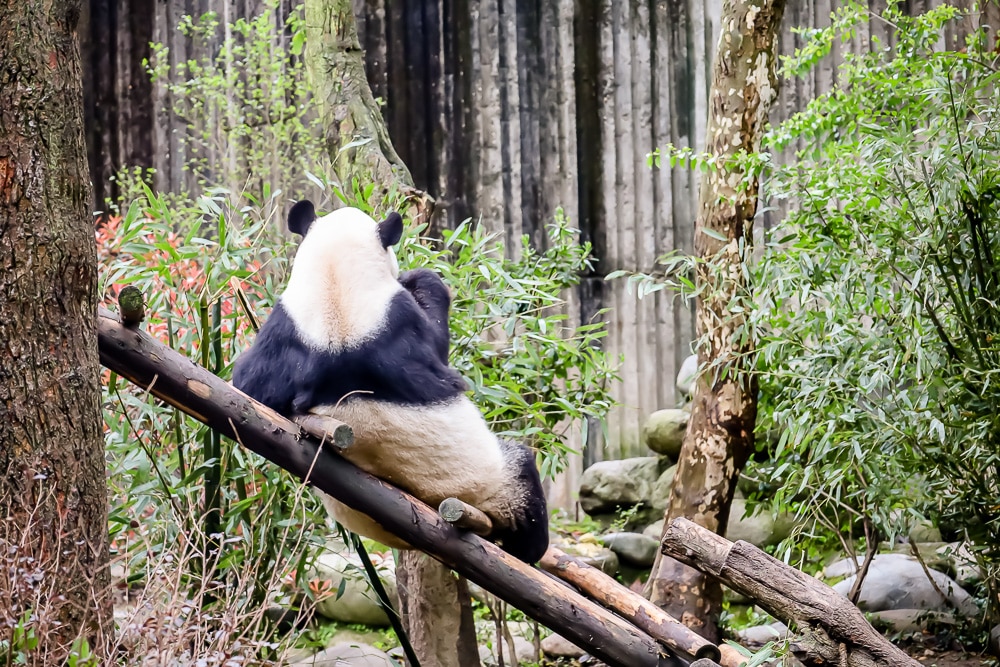
When you say “panda bear”, you clearly mean black and white, but apparently there are also brown pandas! One is in a zoo, and a few live in the wild.
Why on earth are they brown? Due to a rare genetic mutation, not because some panda hooked up with one of our brown bears…
And here’s an even crazier thing! Recently, a completely white panda has been discovered in the wild! It lives in a snowy area, and they still haven’t figured out why it looks like that, although online sources suggest it’s a classic case of albinism. Personally, I’m wondering if maybe the Americans just parachuted in a polar bear from Alaska to mess with the Chinese a bit.
THE PANDA KINDERGARTEN
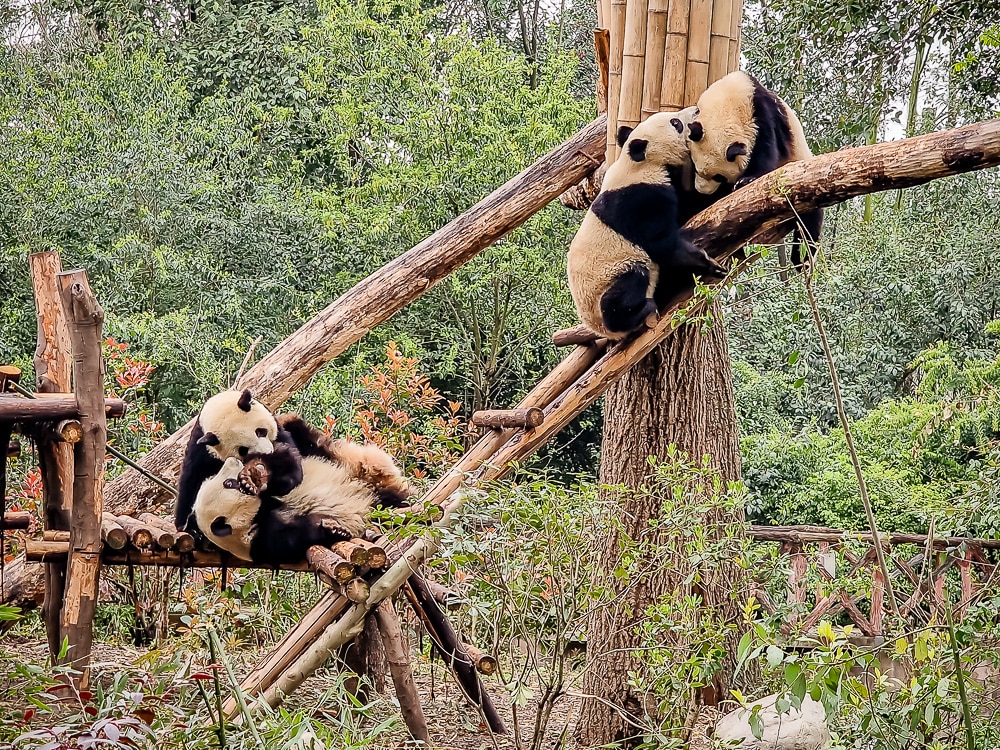
Between the ages of 2 and 5, pandas are… in kindergarten. They’re done with their mama’s milk and now live together, socialize, and play.
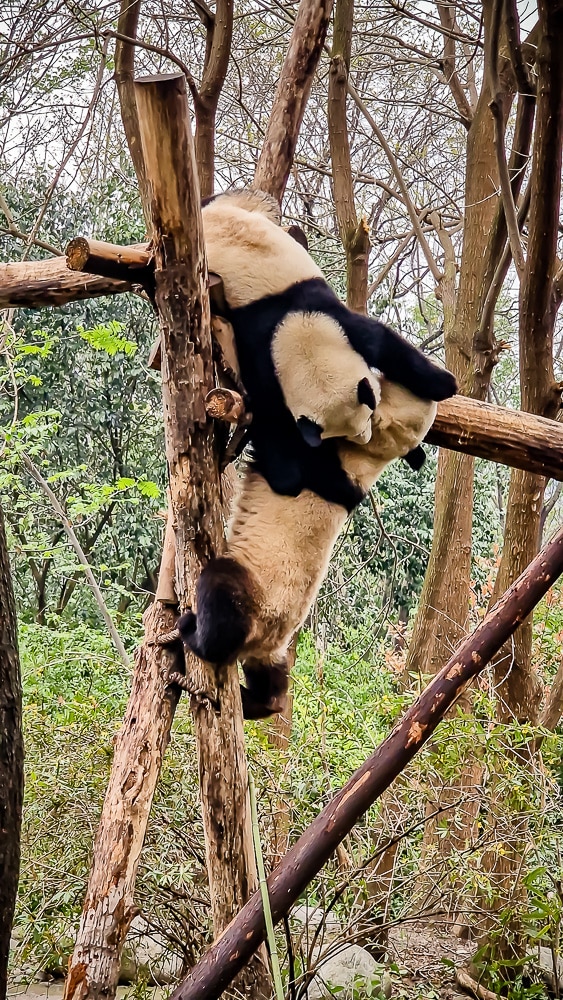
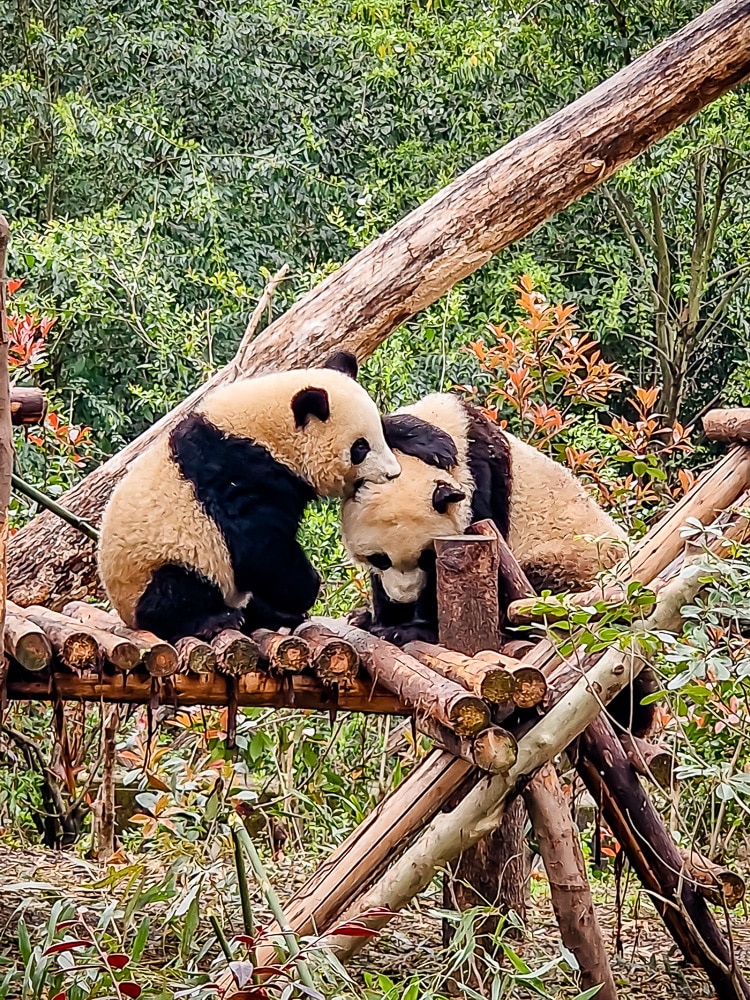
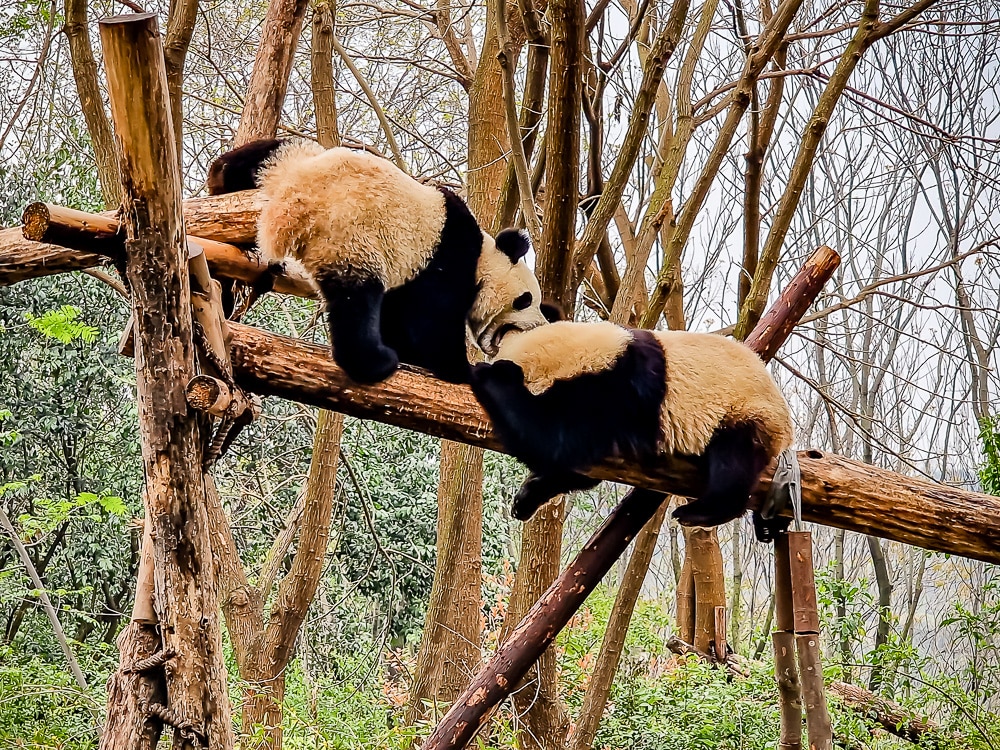
This area is the most crowded, because we’re all gathered here watching what the cubs are doing, laughing at how they roughhouse or swing, and reacting as a group every time one falls on its nose or gets stuck on a log.
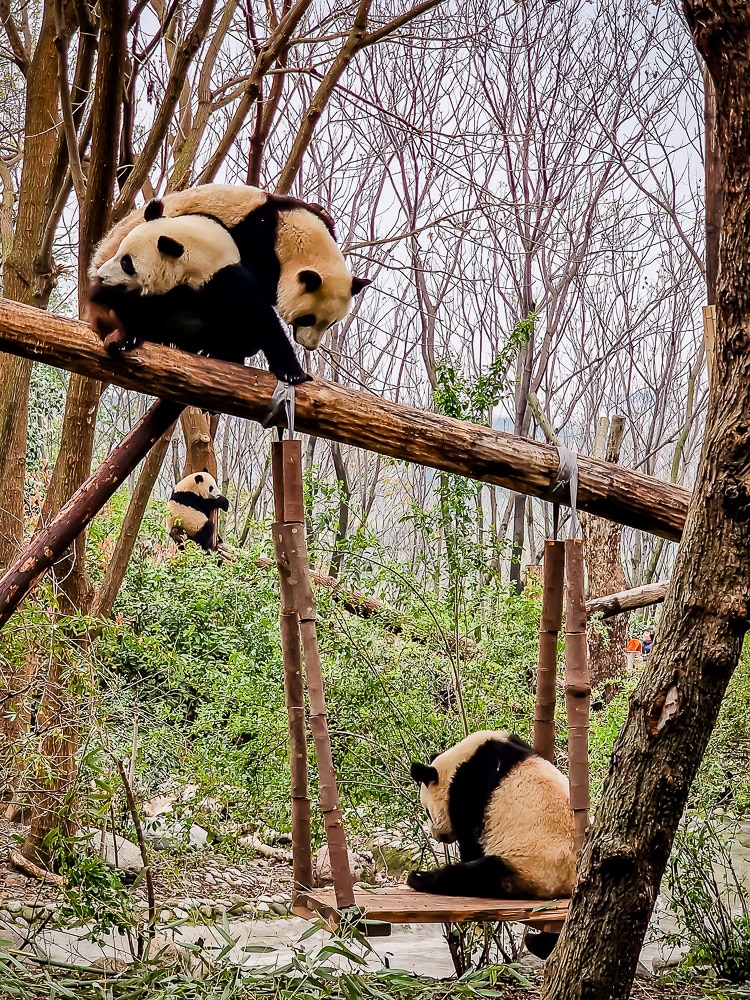
I recorded the four little friends until my hand went numb… And the guide told me, excitedly, that even though she comes here all the time, she’s never seen such fun interaction between them, or ‘accidents’ like these:
The keepers feed them, clean their place, carry them around when needed or… can’t get rid of them – just like in those dozens of cute videos online.
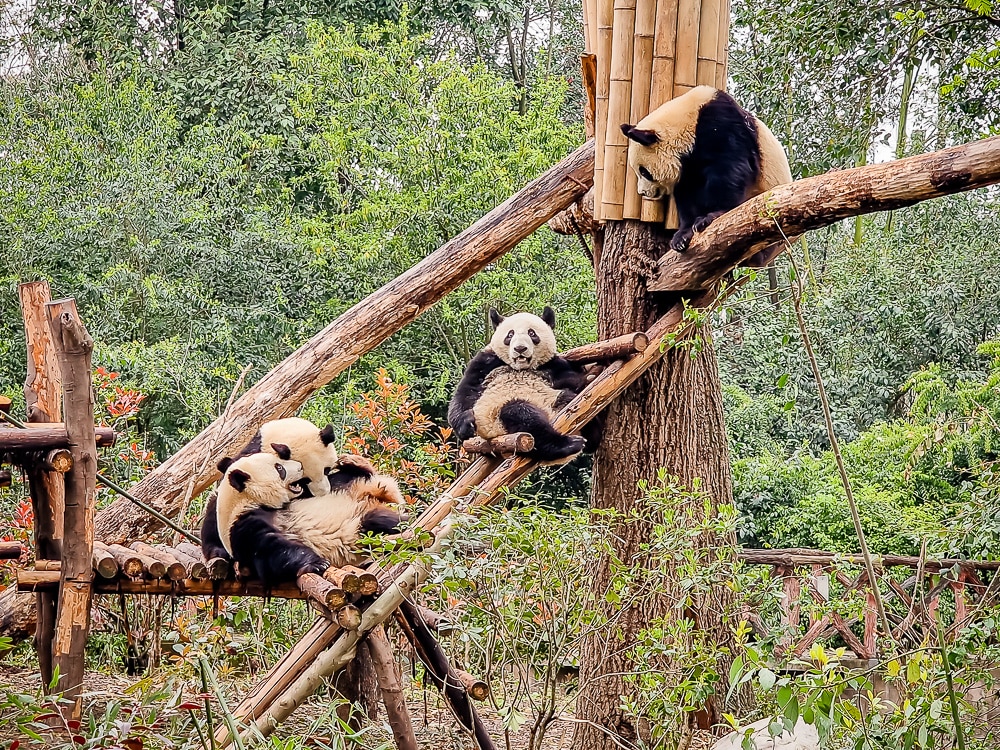
But this only happens with the 2-5 year olds. Because after that, things change.
At 5 years old, pandas enter a new stage – adulthood – and all the kindergartners are separated, because they can no longer live together peacefully. Conflicts begin… And even the keepers can no longer interact directly with them.
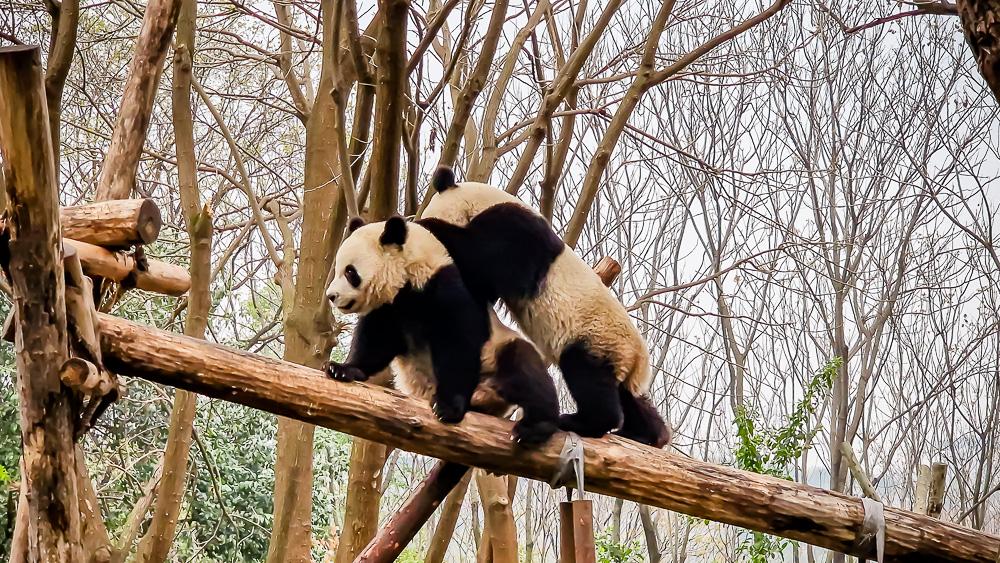
HUA HUA
I think… no, actually I’m sure: I’m the only one in this entire Center who hasn’t heard of the superstar Hua Hua!
Hua Hua is a female panda born in captivity, on July 4th, 2020. Her official name is He Hua, but the whoooole world that knows her, knows her as Hua Hua.
Videos of her get millions of views on Douyin (the Chinese TikTok), and I hear that on another platform she even has billions of views!
Paradoxically, her fame comes from the fact that, unlike her twin sister, she’s born with health problems and wouldn’t have survived in the wild.
What makes her special is the round shape of her head, different from other pandas. Then, the black eye patches, which are also different – they look like upside-down teardrops. And last but not least, her extremely white fur and oddly short little legs…
She’s famous both for her unique appearance and for being an exceptionally calm and gentle panda.
Her popularity is so huge that she’s become a driver of the local economy! Hua Hua souvenirs sell like crazy, and many people travel to Chengdu just to see her!
But don’t think Hua Hua is that easy to spot…
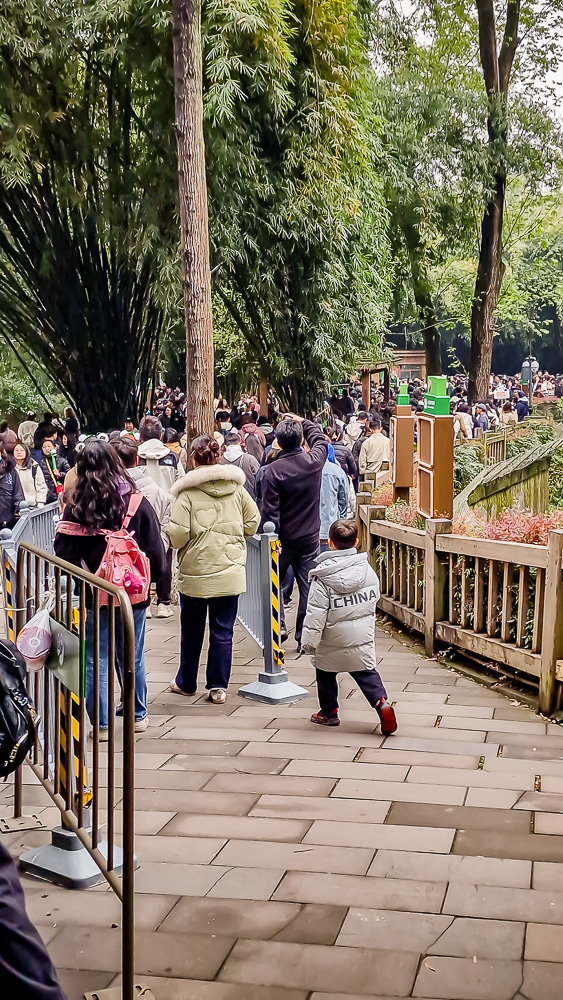
I see a loooong line and I’m shocked: people wait two whole hours just to get in front of Hua Hua’s enclosure, where they have exactly 3 minutes to see/photograph/film her. IF they see her. Because she might not even be outside.
Dude, two hoooours?! That blows my mind!
My guide, a real expert in this place, takes me on a path where, barely squeezing through the bamboo, I catch Hua Hua at breakfast.
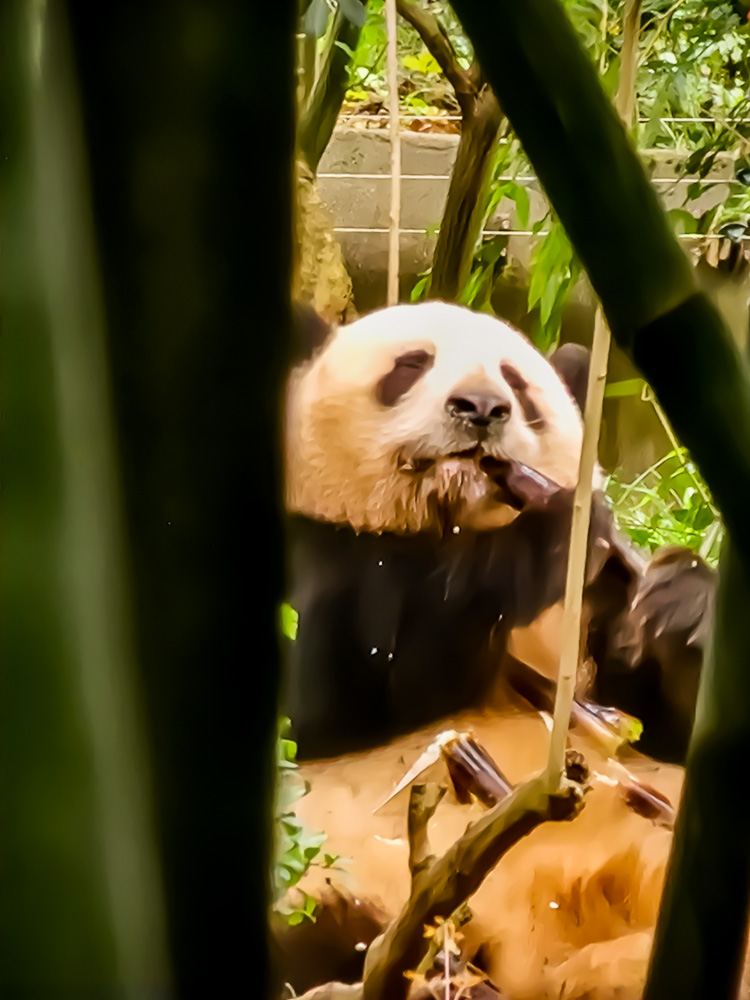
Yuhuuu!!! Without standing in line, I snap a few photos, best I can. Just with my phone, but some people next to me have serious gear and have clearly been lurking there for a while…
My big stroke of luck: right after one group (who waited two hours!) is forced to leave because their 3 minutes are up, I manage to catch her at the perfect moment, just before the next wave of people pushes in from the endless line. So here she is, the famous Hua Hua:
Maybe you knew this already – I had no idea, and I was amazed when I found out: the panda bear actually got its name from another protected species, which I saw for the first time years ago, in a zoo in Hong Kong.
THE RED PANDA
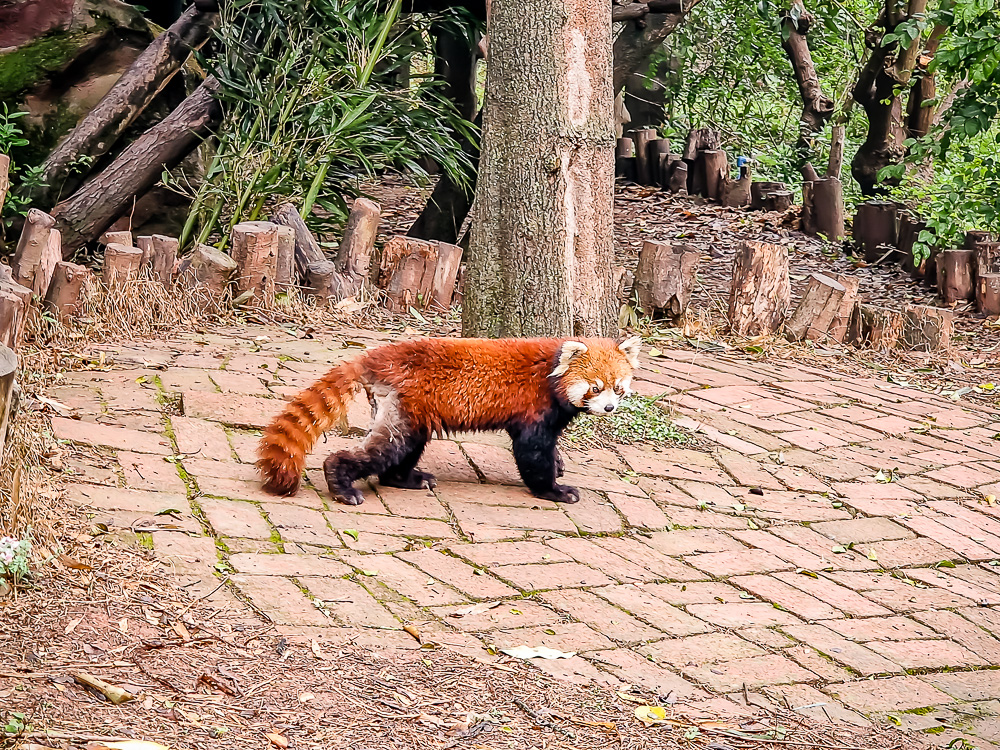
It’s not really a bear, it looks more like a raccoon, and it’s called a “red panda”. Locals call it “fire fox”. I wasn’t thinking of a fox either…
It was discovered in the Himalayas and known to Europeans decades before the black-and-white bear was found. They named it “panda”. Apparently, the word comes from a Nepali term meaning something like “bamboo eater”.
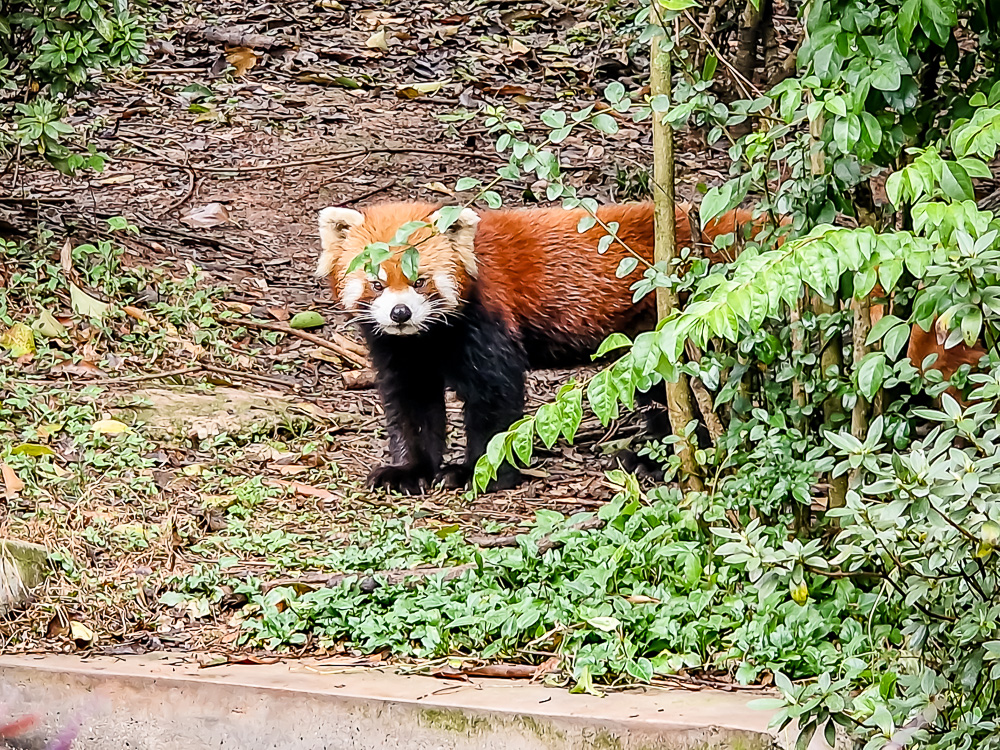
When the black-and-white bear was discovered (in the 19th century), European researchers noticed some similarities with the red panda (even though they belong to different families) – both eat bamboo and both have a modified bone in their paw that acts like an opposable thumb.
So it was simple, they called it “panda” too, just added “bear” or “giant”. Everywhere I’ve seen the term “giant panda”.

Unlike the giant panda, which lives 20 years in the wild and 30 in captivity, the red panda only lives 10 years (14 in captivity).
I admire it here, in captivity, and I analyze it from head to toe… well, to tail. It’s super cute!
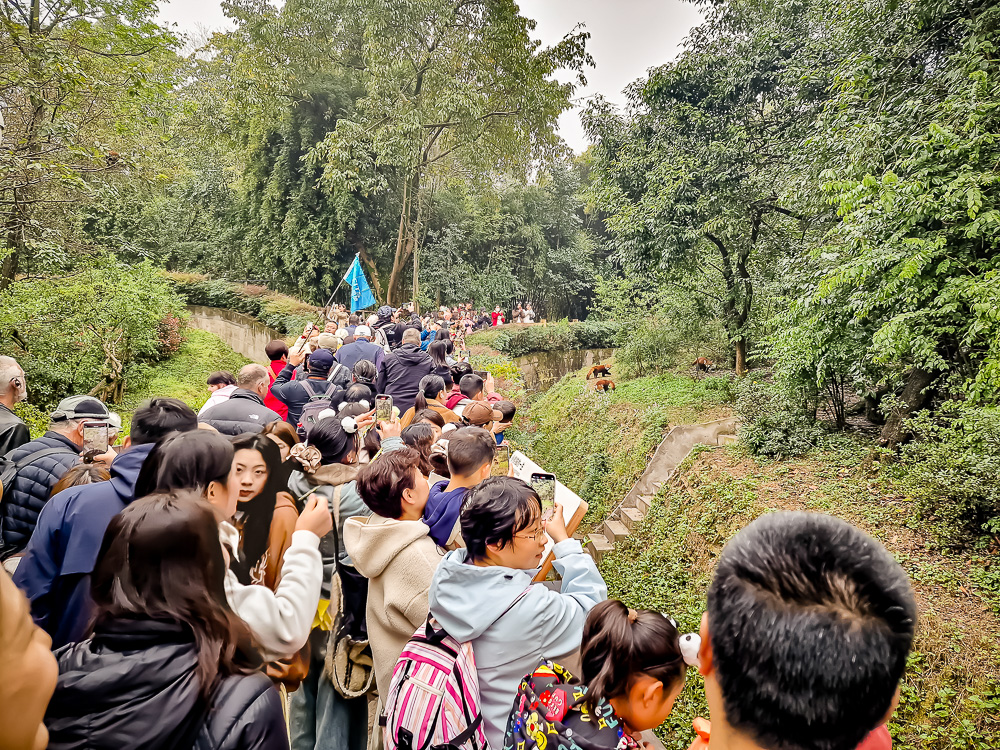
A bunch of people stopped in front of the red pandas! I wait for the groups to pass, then rush for a selfie with one that came pretty close to the fence.
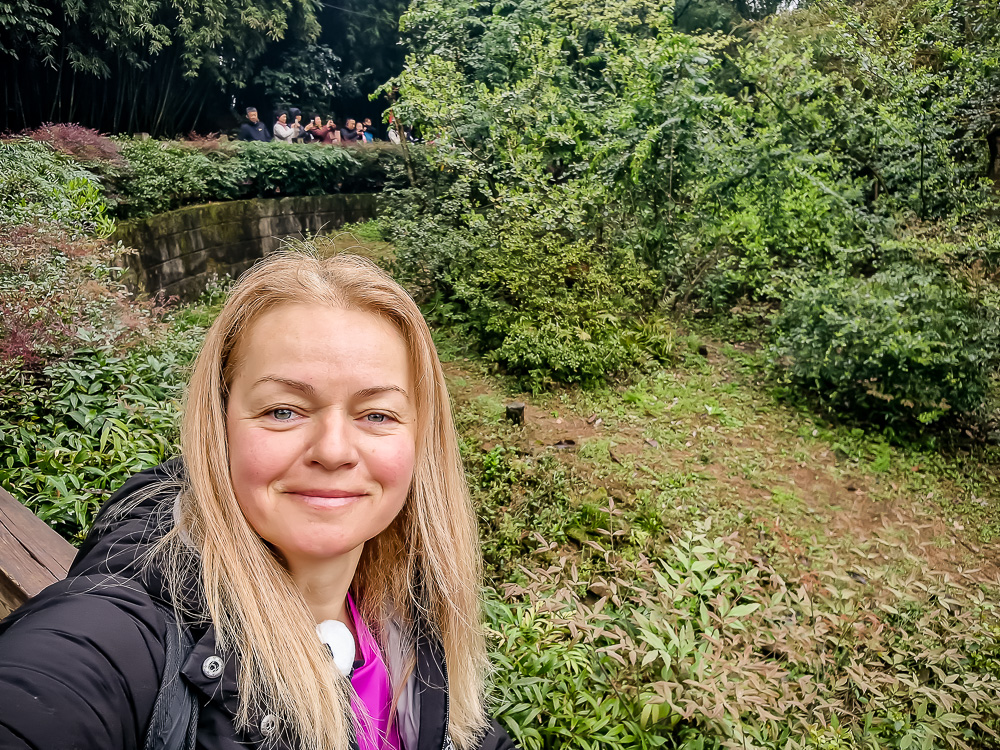
Bummer! By the time I press the button, he runs off into the little forest, so I end up with a perfect selfie of… the bushes.
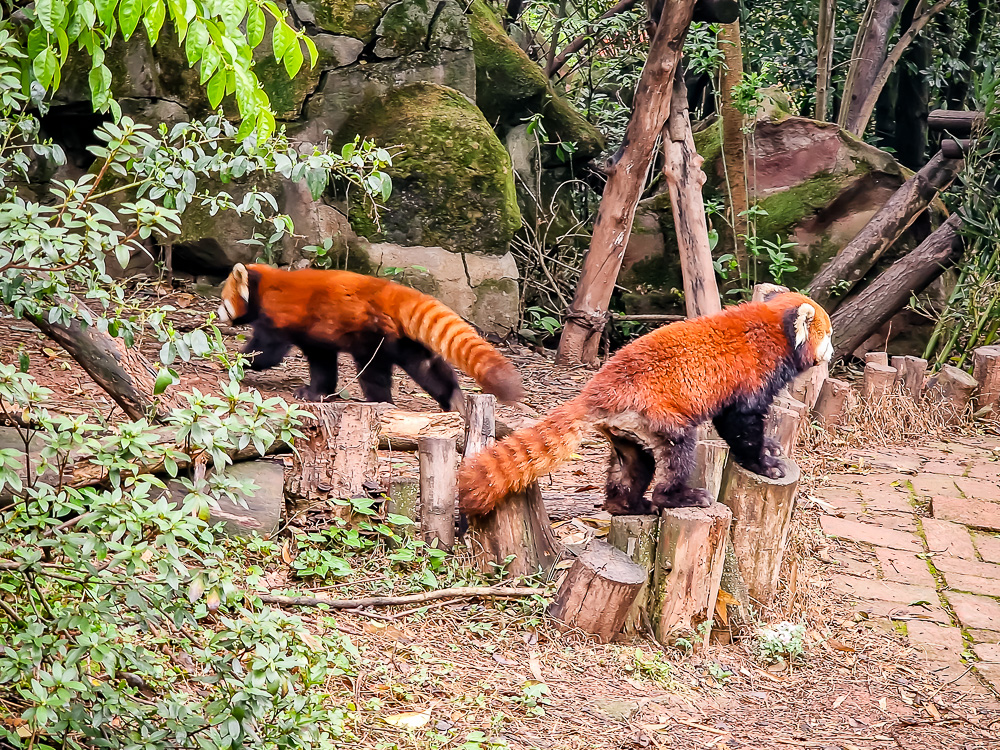
There are many red pandas here, so you can relax and watch them all day long, as long as the center is open… This is the time of day when they’re pacing, impatient, waiting for food.
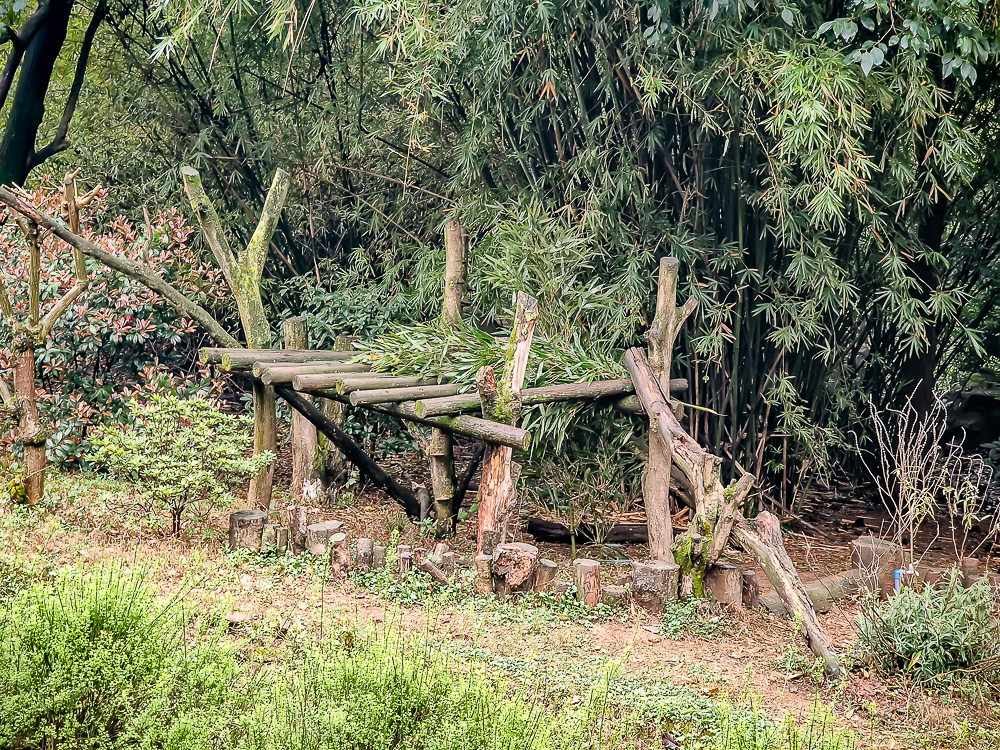
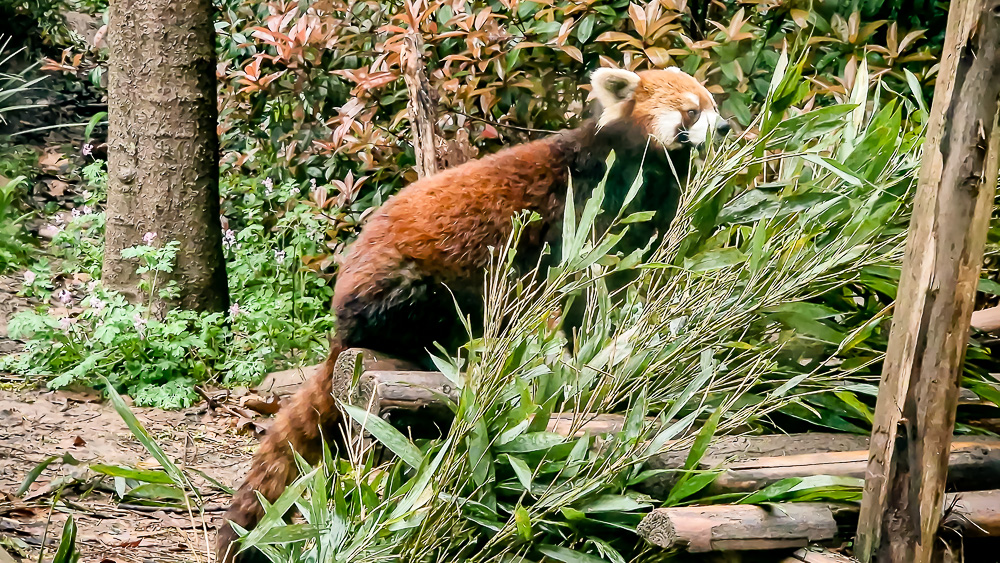
Keepers often place the bamboo on wooden structures to make them climb and move a bit, not just lazily wait for food to be brought to them.
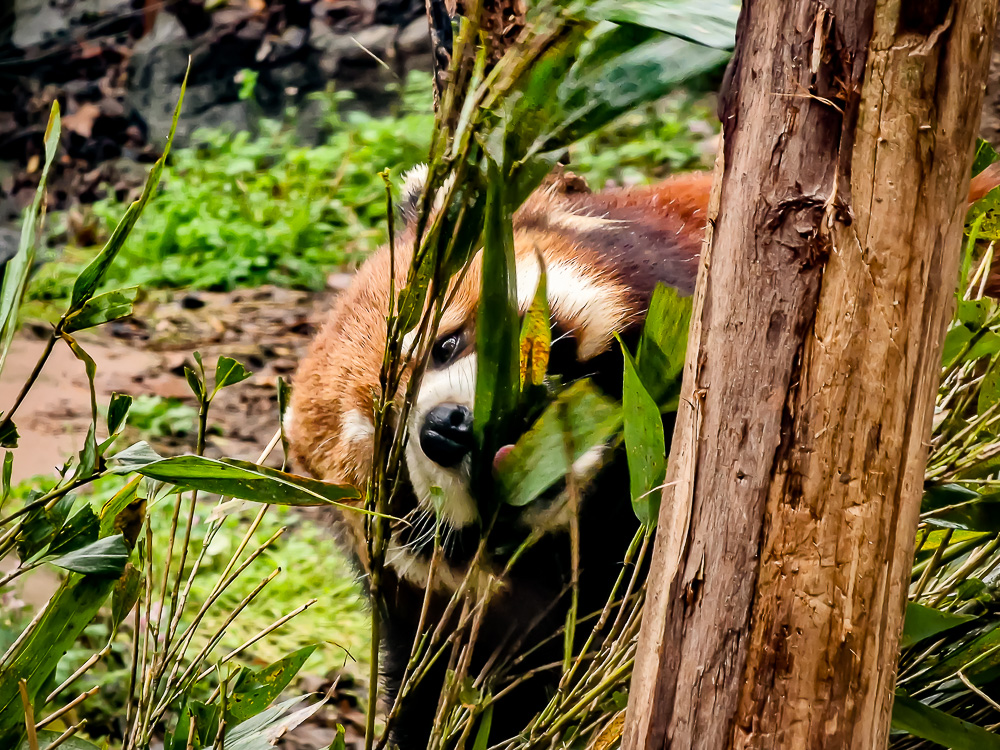
A red panda eats up to 3 kg of fresh bamboo per day – about 30% of its body weight! I read they sometimes nibble on nuts or small mammals/birds, but I didn’t see any of that here. I only saw them happily stuffing themselves with bamboo.
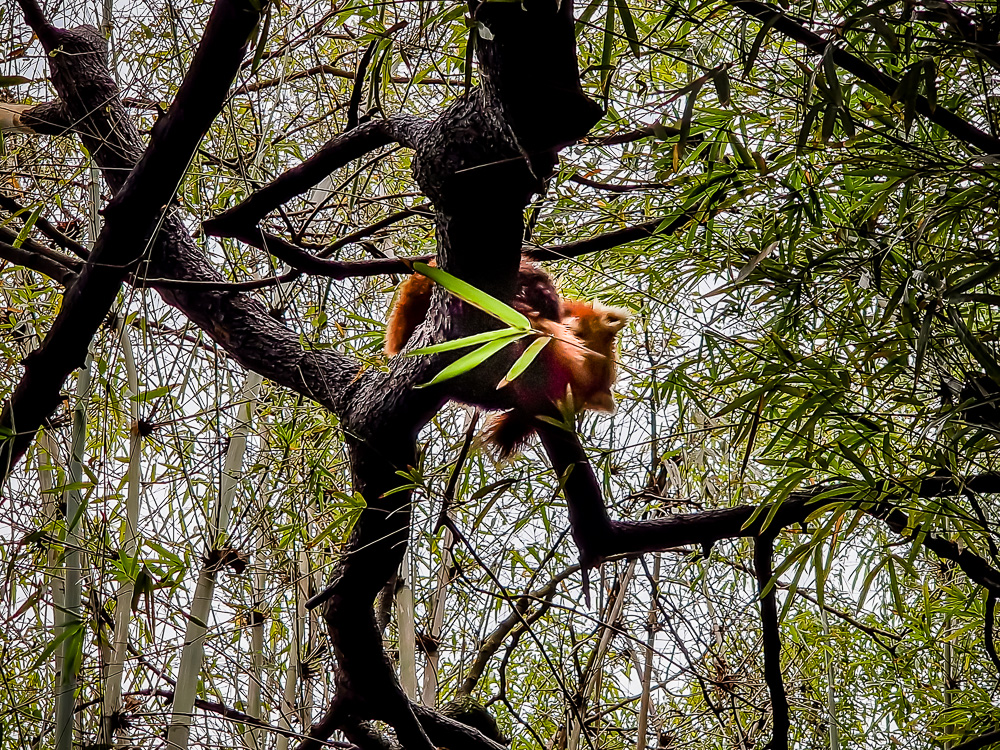
red panda sleeping in a tree
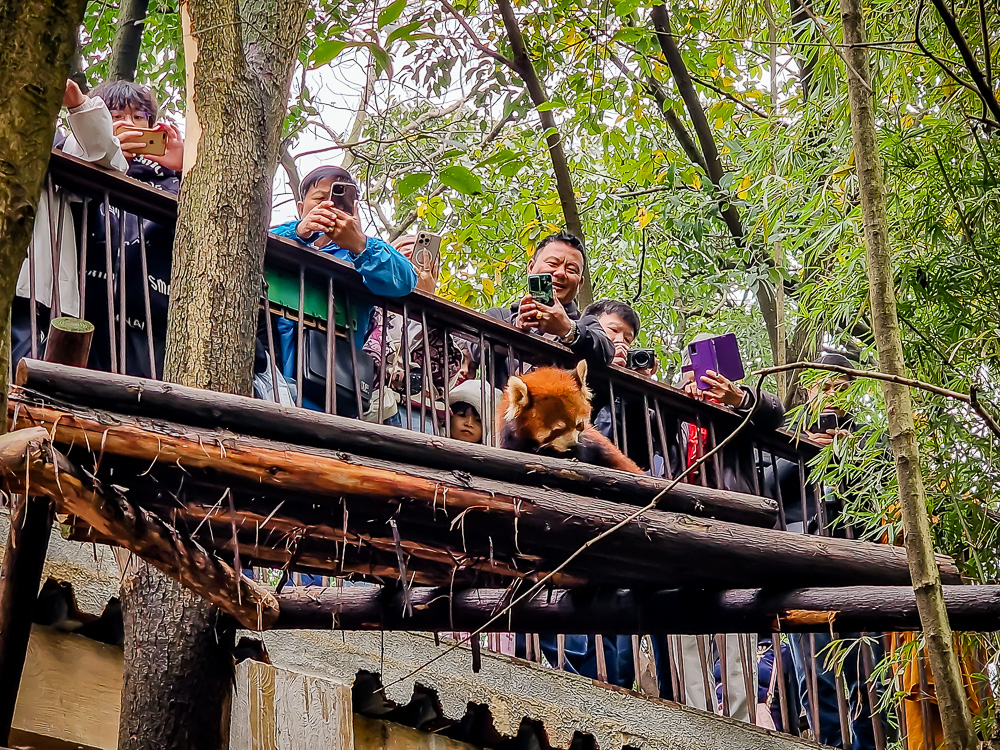
I spent several good hours in this place. You just can’t get bored watching panda bears and red pandas.
I don’t know what it’s like in the afternoon, but mornings are awesome – you’ll catch them all outside, full of energy or super hungry.
If you want a different kind of experience, there’s a Research and Education Center, for those interested in ecology and biology. You’ll also find interactive exhibitions. And of course, gift shops. Perfect for someone like me, haha.
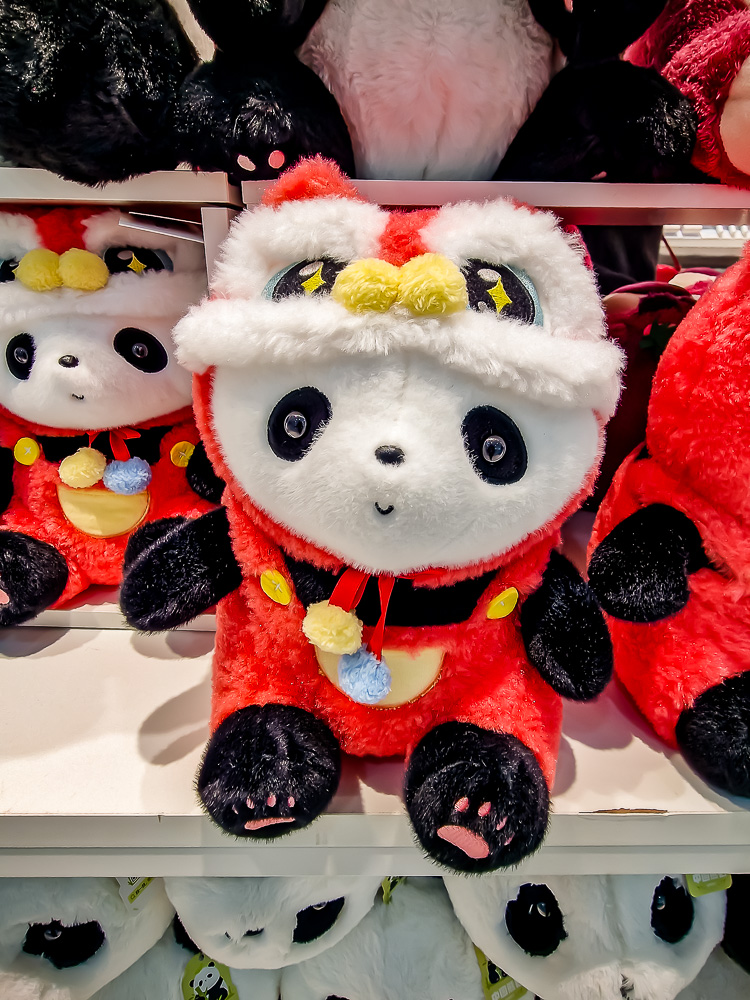
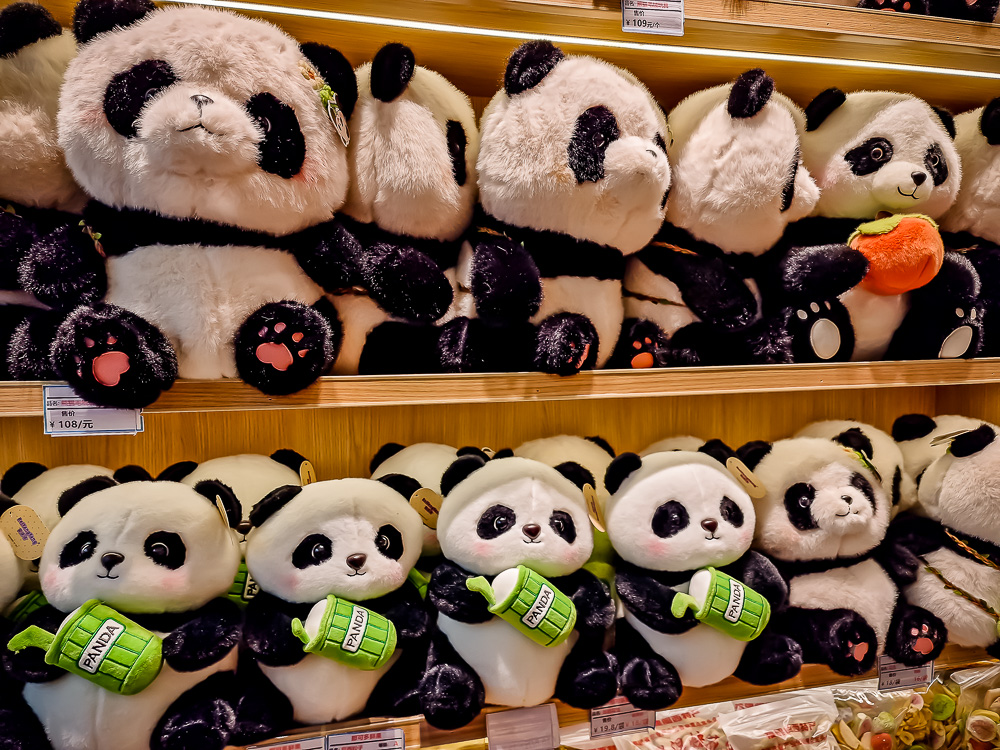
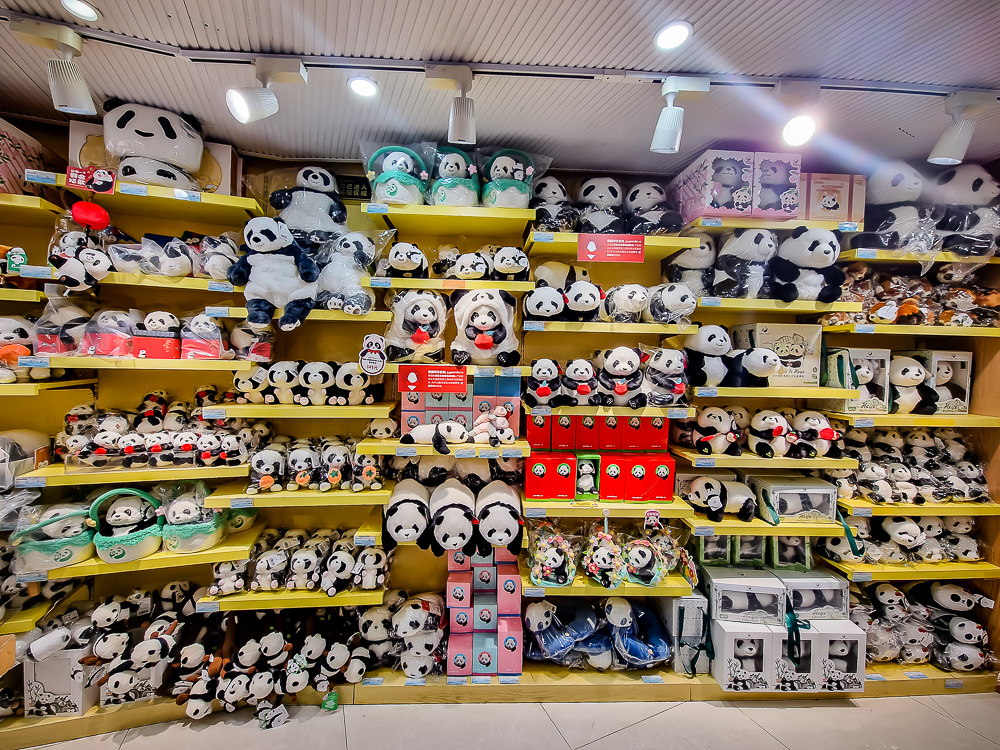
God, I wanted to buy every single panda in the store!!! I restrained myself heroically, especially since I had already splurged at the street markets…
We left, leaving behind waves of tourists (mostly Asian), who had come to see the pandas.

On our way back into the city, I spot – through the car window – a giant panda perched on top of a building! I was going to find out more about it a little later. And how you can take a selfie with it 🙂 I’ve written about that here, along with other unusual experiences I had in the city of Chengdu.


